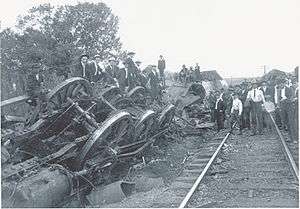New Market train wreck
 Photo of wreck | |
| Date | September 24, 1904 |
|---|---|
| Time | 10.18 a.m.[1] |
| Location |
Jefferson County, near New Market, Tennessee |
| Country | United States |
| Operator | Southern Railway |
| Type of incident | Head-on collision |
| Cause | Engineer error |
| Statistics | |
| Trains | 2 |
| Passengers | 350 |
| Deaths | 56 - 113 |
| Injuries | 106 |
The New Market Train Wreck happened when two Southern Railway passenger trains travelling at great speed collided head on near New Market, Tennessee on Saturday, September 24, 1904, killing at least 56 passengers and crew and injuring 106.
Trains
The trains concerned were the No. 15 westbound local passenger train (pulled by 4-4-0 #1838) from Bristol to Knoxville with three cars carrying 140 passengers, and the No. 12 eastbound 'Carolina Special' (pulled by 4-6-0 #1051) from Chattanooga to Salisbury, North Carolina. The line was a single track and the normal procedure to allow the trains to pass was for the local train to stop on a side track at Hodges' Switch but when the engineer stopped at Morristown he was given special orders to stop in a siding at New Market instead. Both the conductor and engineer signed that they had read the order but later the conductor told a reporter that he had 'mis-read' it.[2] After stopping at New Market, the train should have stopped after a few hundred yards onto the side track but it didn't.
Meanwhile, the 'Carolina Special' had reached Strawberry Plains; it comprised nine cars: two mail cars, three wooden passenger coaches and four steel Pullman cars, many of its 210 passengers were returning from the Louisiana Purchase Exposition (St Louis World's Fair). As it drew out of the station a telegraph arrived from New Market; from horrified depot staff it read "Number 15 has run the switch and is on the main line!", but it was too late, despite waving arms and throwing stones at it, no-one aboard the Special noticed as the train gathered speed. There was one last chance to warn the trains; a telegraph was sent to Hodges' Switch, the normal passing place; but no-one was on duty and the message was never received.[3]
Collision
The trains met on New Market Hill at 10:18 a.m.; the special managed to gather speed on the upgrade and was travelling at 60 mph; the local on the downgrade was trying to make up lost time and attained 70 mph; when they saw each other the emergency brakes were applied but the trains collided at a combined speed of over 100 mph (though a contemporary source says 70 mph)[4] and the crash could be heard 15 miles away. Both engineers were killed. The locomotive and its coal-tender of the local train were catapulted into the air, turning upside down they flew over the Special's engine, tender and baggage cars, landing squarely on top of the wooden passenger cars which were also struck from behind by the weight of the sturdy steel Pullman cars, which remained relatively undamaged. In seven seconds,[3] the wooden coaches were 'crushed like eggshells'.[1] Death was quick for most, with many of the victims decapitated or horribly mangled; 'splintered timbers, iron, and steel were piled in chaotic masses over the rails, mingling with human bodies'.[2] When news of the crash reached Knoxville, a relief train was organised to bring doctors and medical supplies to the site and take the injured to Knoxville General Hospital. Reporters also managed to board the train and many photographs of the scene were made (see here) Estimates as to the death toll vary from 56 (with 106 injured)[2] to 113 dead.[3]
The enquiry could not determine why the engineer and fireman on the No. 15 had not stopped on the side track at New Market as both were killed by the collision; the engineer may have been asleep.[1]
Locomotives
These were the locomotive involved in the wreck.
#1838: This engine pulled Westbound #15. A 4-4-0 American type steam locomotive built by the Schenectady Locomotive Works in 1887 originally as Virginia Midland Railway #692. The engine was later renumbered to 831 in 1894 when the Southern took over the Virginia Midland Railway, then it was renumbered again to 1838 in 1903. When the locomotive collided into Eastbound #12, its boiler broke free from its frames, toppled over the boiler of the Eastbound #12 locomotive, and exploded, completely destroying itself. After the wreck, the engines remains were later collected and sold for scrap. The Southern then replaced this engine with another 4-4-0 (formerly Tennessee Central Railway #9) and renumbered it as its 2nd #1838. It was later sold back to the TCRR in 1909.
#1051: This engine pulled Eastbound #12. A 4-6-0 Ten-Wheeler type steam locomotive built by the Baldwin Locomotive Works in 1897, new for the Southern Railway. After the wreck, the locomotive was later repaired and continued to serve the Southern Railway until it was scrapped at Princeton, Indiana on June 5th, 1930.
References
- 1 2 3 Railroad Wrecks by Edgar A. Haine, p65-66, publ 1993, ISBN 0-8453-4844-2
- 1 2 3 http://www.medscape.com/viewarticle/704168 Disaster Management at the 1904 New Market, Tennessee Train Wreck: Role of a Surgeon
- 1 2 3 "History of the New Market Train Wreck". Jefferson County Schools. Jefferson County Schools. Archived from the original on 8 June 2012. Retrieved December 13, 2017.
- ↑ http://www3.gendisasters.com/tennessee/555/hodges,-tn-train-wreck,-sept-1904 Hodges, TN New Market Train Wreck, Sept 1904
External links
- History of the New Market Train Wreck
- Disaster Management at the 1904 New Market, Tennessee Train Wreck: Role of a Surgeon
- Hodges, TN New Market Train Wreck, Sept 1904
Coordinates: 36°04′46″N 83°37′47″W / 36.079349°N 83.629818°W